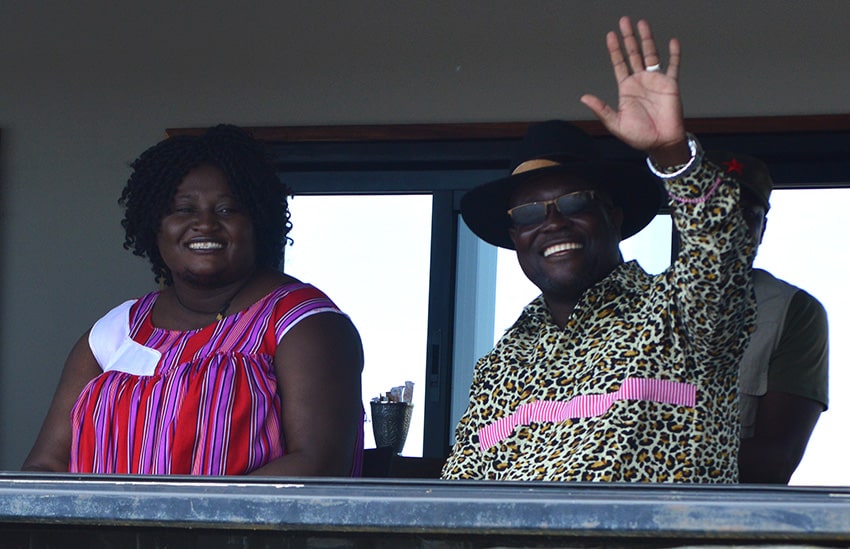Numerous livestock and/or game farmers have purchased the necessary machinery to operate the electrically powered shredders and mixers in the middle of the bush. The fodder is packed into bags on the spot and then distributed to the various feeding stations on the farm.
Dirk Heinrich
On most of the country's farms there is currently not a single blade of grass left. Farmers have drastically reduced their livestock and moved the small number of remaining animals to the few grazing areas available for rent, or they feed their animals with shredded bush. The latter is a solution which sees the animals through until the next rainy season and at the same time solves the problem of bush encroachment.
Even game farmers use this method to save their wildlife and to economise. In previous drought years some game farmers spent more than a million Namibia dollars on fodder. But since most of southern Africa is currently in the grips of a particularly severe drought, feed such as grass or alfalfa is difficult to obtain and extremely expensive.
Supplementary feed in the form of shredded bush seems to be a worthwhile alternative in many cases. To get the animals to eat this fodder is not so easy, however. And bush alone does not guarantee the survival of cattle and game. The switch from grass to the bush mixture has to be made gradually, and each farmer has to find out for himself which additives he should use in order to provide fodder that is not only tasty and digestible but also contains sufficient minerals and trace elements so that the animals stay healthy and maintain their condition, or even improve it.
Five years ago the game farmer and chairman of the Namibian Charcoal Association (NCA), Gunter Schwalm, with the help of experts in Germany started to analyse shrubs and trees such as the silver cluster-leaf (Terminalia prunoides), the mopane tree (Colophospermum mopane) and the sicklebush (Dichrostachys cinerea). They are a problem on his farm of almost 6500 ha, because especially the silver cluster-leaf and the sicklebush grow so thickly that no grass sprouts underneath and few animals can get through the thicket. Large parts of the farm are barely usable because bush has taken over, and so are another 32 million hectares in Namibia.
With the right feed supplement a bush-fodder-mix can be offered to grazers such as white rhino and to browsers such as the eland, as seen here on one of the country’s many game farms.
“We established the protein content and which substances are missing, in order to produce a good feed using the bush. Then I shopped around to see what I can get in the vicinity, or for a good price – things like maize meal, lick concentrate (a food supplement), phosphate and molasses”, Schwalm says. After repeatedly changing the bush-fodder-mix it is now accepted by all the game species, from hartebeest, sable antelope, kudu and eland to wildebeest, waterbuck, gemsbok and Hartmann zebra. “It helped that for the past 20 years I have always provided licks for the game between the rainy seasons”, Schwalm points out. “Therefore the animals knew the taste and probably also the benefits of the supplement.” Apart from identifying the various tree and bush species, grass species and soil samples were also studied on Schwalm’s farm over the years.
It is no longer a secret that farmers who feed a bush-fodder-mix to their livestock and/or game also need to have their water tested because it could contain substances which for example could neutralise minerals in the feed supplement or cause another deficit, while certain minerals could already be present in abundance.The average rainfall on Gunter Schwalm’s farm is 550 millimetres per season. In the 2018/2019 rainy season it was only between 50 and 85 mm. “Fortunately I had already started to produce charcoal in the previous years of drought, to secure an additional income and also to tackle the bush encroachment at the same time”, Schwalm says. The thin, fresh shoots of the bushes cut down earlier now come in handy for the bush-fodder-mix. Many game species used to eat the young shoots anyway and thus helped to keep bush encroachment in check, Schwalm explains. Even springbok and gemsbok eat those shoots. Schwalm started to make charcoal in 2013 and produces some 1600 tons per year. “Combining charcoal production with using the delicate twigs and shoots for fodder was ideal”, the game farmer says. “We now have more species of grass on the farm than we had 20 years ago and we also have a lot more bushes suitable for fodder.”
However, every farmer needs to analyse his farm himself, consider the different soil types, have his water tested and know his vegetation. Wherever areas are overgrown by bush and thus become unproductive, the production of charcoal and a bush-fodder-mix is an important source of income and animal feed, especially in periods of drought. Most of the country's farms use the blackthorn (Acacia mellifera), which accounts for much of the bush encroachment in Namibia.
With special disk saws the thorny and dense shrubs are cut off just above the ground. Many farmers do not want to kill the sawn bush with poison, but rather let it regrow for repeated use.





SUBMIT YOUR COMMENT